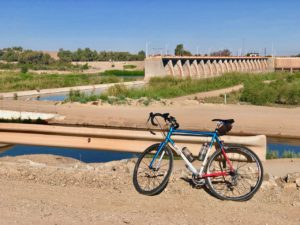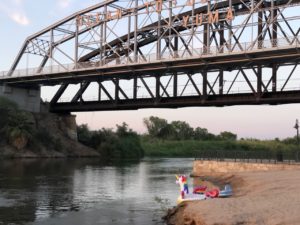YUMA – I brought a bicycle this week on a road trip to the Lower Colorado River, and left myself the morning today to ride out to Morelos Dam.
After a quick morning of meetings yesterday in Tucson with the University of Arizona Press folks turning our words into a book, I drove on to Yuma for the night. Yuma is in the lettuce pocket at the bottom of the Colorado River, and it’s one of my happy places. I dumped my luggage at a riverside hotel (they got me a room facing the Colorado), drove to In-N-Out, and took my dinner and a camera down to Yuma’s Gateway Park.
I love this park. Families families were picnicking and floating, including a rainbow unicorn (right).
This morning I rode west, juggling gravel levee road and paved (and narrow) farm road to get to Morelos. It’s six miles by line of site, but I logged 20 there and back with the jogs this way and that wandering down narrow farm roads and gravel levees.
Morelos is the last dam on the Colorado, sending what’s left of the river at this point to the west, to the farms and cities of the Mexicali Valley.

My trusty bicycle, Morelos Dam on the U.S.-Mexico border, June 18, 2019.
I first came here in the spring of 2010, was struck by seeing the end of the Colorado River:
The first time I saw this, I was stunned. Driving the Yuma County levee past Morelos Dam in 2010, I saw the last trickles of water from leaks in the dam and a shallow water table disappear within a few miles into a sandy, dry channel. This great river, the Colorado, around which I have spent much of my life, whose water I have showered with and drunk, which has grown the food I eat and floated my boats for hundreds of miles, simply disappears into the desert sand.
That’s from Water is For Fighting Over, which came out in 2016. I quit a job to write that one, got a new job, wrote a new book (Science Be Dammed, also about the Colorado River), and now I’m back for more.
Morelos remained striking for me when I rode my bike out there this morning, but in ways that grow have only grown more complicated since I first saw it in 2010. I was playing a game with the paragraph above that remains my unfinished business – setting my “OMG the river ends!” against the benefits I have received – “whose water I have showered with and drunk, which has grown the food that I eat”. I’m spending time on this trip with people who do the food-growing piece – in the Imperial and Palo Verde valleys.
The Colorado River at Yuma, where I took a dip to cool off after my bike ride, was flowing at ~1,100 cubic feet per second this morning. Downstream from Morelos, that drops to ~0 cfs. Upstream from Yuma, the All-American Canal is running at about 5,000 cfs. I got an email from my collaborator Eric Kuhn, who did a similar bike ride this morning where he lives, in the mountains of western Colorado – bankful at 17,000 cfs. It’s a complicated system.

Colorado River at Glenwood Springs, June 18, 2019. By Eric Kuhn


I love your bike’s colors.
I hope you brought your sombrero, John. Summer in the desert. Enjoy your trips to PVID, IID, etc.